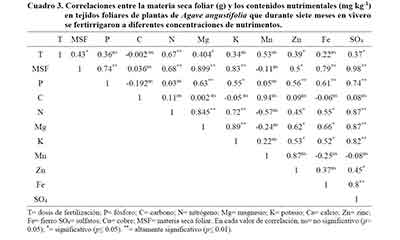Growth of Agave angustifolia Haw. in relation to its nutritional condition
DOI:
https://doi.org/10.29312/remexca.v12i5.2638Keywords:
agave, fertigation, nutrientsAbstract
Agave angustifolia Haw. plants, which are obtained by asexual propagation (inflorescence bulbils and rhizome suckers), are established in a nursery where they are provided with agronomic management that is considered to include the supply of nutrients, to achieve quality plants in health and vigor that are successfully established in the field. The research was carried out from January 2017 to August 2018, in the nursery of the Technological Institute of the Valley of Oaxaca, located in the Exhacienda de Nazareno, Xoxocotlán, Oaxaca, Mexico, the objective was to evaluate the nutritional contents in foliar tissues and the size of Agave angustifolia plants, in nursery conditions, fertigated at different concentrations of nutrients. For seven months, four groups of plants that were in soil of loamy-sandy texture were applied different types of irrigation: water or nutrient solution (SN) at 50, 75 and 100% of the Steiner formulation, after that time, their growth was evaluated. In leaf samples, the nutritional contents were analyzed, and the plants to which water was applied, SN-50%, SN-75% and SN-100%, had in mg kg-1 of foliar dry matter: 7 225, 10 641, 12 575 and 14 957 of N; 3 017, 5 018, 5 297 and 6 719 of P; 7 827 19 604, 16 220.1 and 18 847 of Mg, accumulated, 282.74, 340.11, 431.98 and 453.05 g of foliar dry matter, as well as 75.01, 77.21, 95.92 and 103.14 g of dry matter in the root, respectively.
Downloads

Downloads
Published
How to Cite
Issue
Section
License
Copyright (c) 2021 Revista Mexicana de Ciencias Agrícolas

This work is licensed under a Creative Commons Attribution-NonCommercial 4.0 International License.
The authors who publish in Revista Mexicana de Ciencias Agrícolas accept the following conditions:
In accordance with copyright laws, Revista Mexicana de Ciencias Agrícolas recognizes and respects the authors’ moral right and ownership of property rights which will be transferred to the journal for dissemination in open access. Invariably, all the authors have to sign a letter of transfer of property rights and of originality of the article to Instituto Nacional de Investigaciones Forestales, Agrícolas y Pecuarias (INIFAP) [National Institute of Forestry, Agricultural and Livestock Research]. The author(s) must pay a fee for the reception of articles before proceeding to editorial review.
All the texts published by Revista Mexicana de Ciencias Agrícolas —with no exception— are distributed under a Creative Commons License Attribution-NonCommercial 4.0 International (CC BY-NC 4.0), which allows third parties to use the publication as long as the work’s authorship and its first publication in this journal are mentioned.
The author(s) can enter into independent and additional contractual agreements for the nonexclusive distribution of the version of the article published in Revista Mexicana de Ciencias Agrícolas (for example include it into an institutional repository or publish it in a book) as long as it is clearly and explicitly indicated that the work was published for the first time in Revista Mexicana de Ciencias Agrícolas.
For all the above, the authors shall send the Letter-transfer of Property Rights for the first publication duly filled in and signed by the author(s). This form must be sent as a PDF file to: revista_atm@yahoo.com.mx; cienciasagricola@inifap.gob.mx; remexca2017@gmail.
This work is licensed under a Creative Commons Attribution-Noncommercial 4.0 International license.


